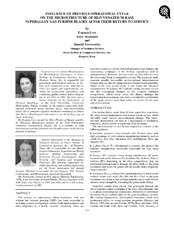| dc.contributor.other | Turbomachinery Symposium (29th : 2000) | |
| dc.creator | Lvov, Evgenia | |
| dc.creator | Norsworthy, Donald | |
| dc.date.accessioned | 2017-10-05T14:00:29Z | |
| dc.date.available | 2017-10-05T14:00:29Z | |
| dc.date.issued | 2000 | |
| dc.identifier.uri | https://hdl.handle.net/1969.1/163371 | |
| dc.description | Lecture | en |
| dc.description | Pg. 113-124 | en |
| dc.description.abstract | The practice of rejuvenating reheat treatments, with and without hot isostatic pressing (HIP), has been successful in restoring severely overaged gas turbine blade microstructure and alloy properties to a nearly “as-new” condition. There are numerous studies on service-induced microstructural damage and rejuvenating techniques of the Ni-base superalloys used in turbomachinery. However, data are scarce on alloy behavior after the rejuvenated blade is returned to service. The presented study concerns specific irreversible service-induced microstructural changes that can alter the aging kinetics of rejuvenated superalloy blades in the next service cycle. It was found that advanced decomposition or primary MC carbides during previous service and the consequent changes of the γ-matrix chemical composition, which occur when the blades undergo the rejuvenating heat treatment, can cause a considerable acceleration of the aging process upon their return to service for the next operational period. | en |
| dc.format.medium | Electronic | en |
| dc.format.mimetype | application/pdf | |
| dc.language.iso | en | |
| dc.publisher | Texas A&M University. Turbomachinery Laboratories | |
| dc.relation.ispartof | Proceedings of the 29th Turbomachinery Symposium | en |
| dc.subject.lcsh | Turbomachines | en |
| dc.title | Influence Of Previous Operational Cycle On The Microstructure Of Rejuvenated Ni-Base Superalloy Gas Turbine Blades After Their Return To Service. | en |
| dc.type.genre | Presentation | en |
| dc.type.material | Text | en |
| dc.identifier.doi | https://doi.org/10.21423/R11378 | |


